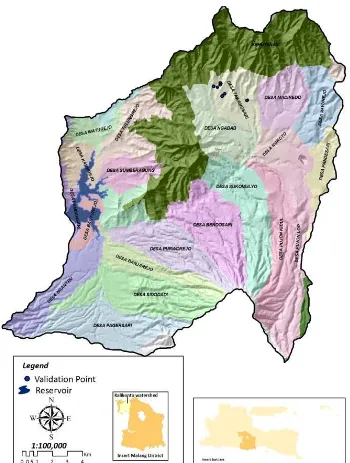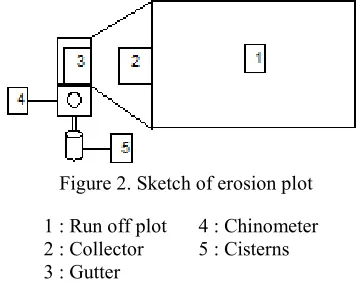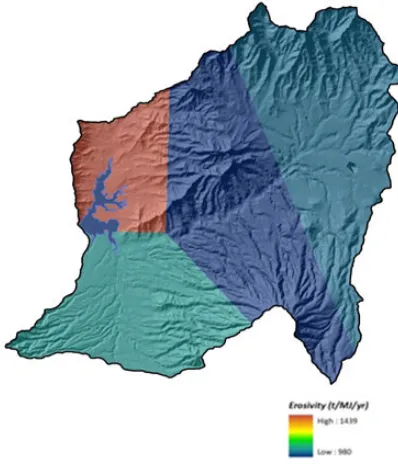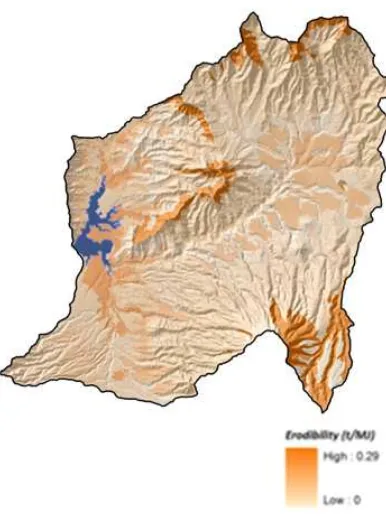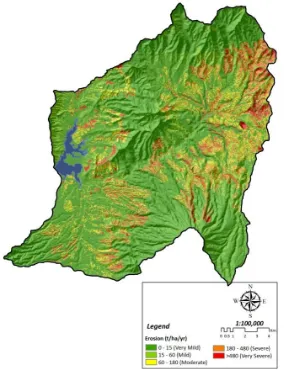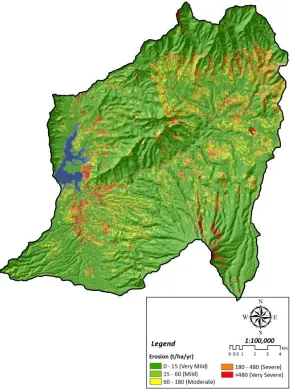ISSN: 2339-076X, Volume 3, Number 1 (October 2015): 459- 468
DOI:10.15243/jdmlm.2015.031.459
Research Article
Estimation of soil erosion for a sustainable land use planning: RUSLE
model validation by remote sensing data utilization in the Kalikonto
watershed
C. Andriyanto
1*, Sudarto
2, D. Suprayogo
2 1Postgraduate Programme, Faculty of Agriculture, Brawijaya University, Jl. Veteran, Malang 65145, Indonesia. 2
Department of Soil Science, Faculty of Agriculture, Brawijaya University, Jl. Veteran, Malang 65145, Indonesia.
* corresponding author: [email protected]
Abstract:
Technology of Geographic Information Systems (GIS) and Remote Sensing (RS) are increasingly used for planning and natural resources management. GIS and RS is based on pixels is used as a tool of spatial modeling for predicting the erosion. One of the methods developed for predicting the erosion is a Revised Universal Soil Loss Equation (RUSLE). RUSLE is the method used for predicting the erosion associated with runoff gained from five parameters, namely: rain erosivity (R), soil erodibility (K), length of slopes (L), slope (S), and land management (CP). The main constraint encountered in the process of operating the GIS is the calculation of the slope length factor (L).This study was designed to create a plan of sustainable land use and low erosion through the RULSE erosion modeling by utilizing the remote sensing data. With this approach, this study was divided into three activities, namely (1) the preparation and analysis of spatial data for the determination of the parameters and estimating the erosion by using RUSLE models, (2) the validation and calibration of the model of RUSLE by measuring soil erosion at the scale of plots on the field, and (3) Creating a plan of sustainable land use and low erosion with RUSLE. The validation erosion shows the value of R2 = 0.56 and r = 0.74. Results of this study showed that the RUSLE model could be used in the Kalikonto watershed. The erosions at the value of the actual estimation, spatial Plan (RTRW) and land capability class in the Kalikonto watershed were 72t / ha / year, 62 t / ha / year and 58 t / ha / year, respectivelyKeywords: erosion, GIS, RUSLE
Introduction
Technology of Geographic Information Systems (GIS) and Remote Sensing (RS) are increasingly used for planning and natural resources management. GIS is used as a pixel-based spatial modeling tool in predicting erosion on lands with complex topography (Lorito et al., 2004). GIS technology can help integrate the various data sets and generate spatial analysis for making a decision in various environmental problems one of which is soil erosion (Jasrotia and Singh, 2006).
Lack of proper land management and land use are factors that most influence on the degradation of land in the study area Kalikonto watershed. Landscape in Kalikonto watershed spread over the area of Mount Arjuna, Mount Anjasmara, Mount Rawung, Mount Preteng,
can be characterized if one land erosion rates is equal to or below the value erosion that can be allowed (Dewi et al., 2012). Some applications and models that have been used to estimate the danger of erosion showed a more accurate and faster than with conventional methods (Tagil, 2007; Irvem et al., 2007). The use of GIS in hydrological models can also reduce analysis costs, and save time. One of the models used is the Revised Universal Soil Loss Equation (RUSLE) developed from the Universal Soil Loss Equation (USLE) (Renard et al., 1997).
RUSLE model is an empirical model which uses equal to USLE empirical principles, but includes numerous improvements in the calculation of various factors (Kumar and Kushwaha, 2013). RUSLE model predicts the erosion associated with runoff obtained from the five parameters, namely: rain erosivity (R), soil erodibility (K), slope lengths (L), slope (S), and land management (CP). The equation used in the USLE formula and RUSLE formula is equal, but different in the segment of slope. The USLE uses macro slope, while in the RUSLE uses slope phase. In the implementation, there are differences in the calculation of the parameters of slope length (L) and slope (S) (Asdak, 2010). LS factor is determined by the length of the slope and slope are adjusted to the level of the slope, where the slope≤9% value S - 10.8 Sinα+ 0.03 and≥ 9% slope value S - 16.8 Sin α - 0.50 (Renard et al., 1997).
The main constraint encountered in the operation of GIS is calculation of the slope length factor (L). The RUSLE model does not allow to calculate the entire length of the slopes in the any form of the slopes in the catchment areas, while the factor of slope (S) can be obtained by using GIS data (As-syakur, 2008). LS factor in GIS applications can be obtained from multiple data, among others: Digital Elevation Model (DEM), Shuttle Radar Topography Mission (SRTM), and the contours from RBI map. The research about the model of erosion using RUSLE models has been done by several researchers (Demirci and Karaburun, 2012; Aroussi et al., 2013; Kumar and Kushwaha, 2013), but validation of model of RUSLE with direct measurements in the field has never been performed.
This study was aimed to determine the amount of erosion in the Kalikonto watershed using the RUSLE model, as well as calibration and validation of erosion models by direct field measurements on scale of plots.
Material and Methods
Study area
The study was conducted at the Kalikonto watershed, whereas RUSLE model validation with soil erosion measurement on scale of plots was carried out in the Tawangsari Village from October 2013 to April 2014 (Figure 1). Based on Schmidt-Ferguson climate classification, Kalikonto watershed is included in the C climate (slightly wet) with a ratio (Q) between the average number of months of wet and dry is 0.56. The average of annual rainfall is 2,509 mm / year. Rainfall is spread with the peak of the rainy season occurs from October to May marked the rainfall exceeding 100 mm / day and occurs in the dry season from June to September marked with rainfall of less than 60 mm / day.
Research approach
This study was designed to create a plan of sustainable land use and low erosion through RUSLE erosion modeling with the Utilization of Remote Sensing Data. With this approach, this study was divided into three activities, namely (1) the preparation and analysis of spatial data for the determination of the parameters and estimation erosion with RUSLE models; (2) calibration and validation models RUSLE through measurement of soil erosion on a scale of plots on the field, and; (3) Creating a plan of sustainable land use and low erosion with RUSLE.
Estimation RUSLE model utilizing spatial data
Preparation of base maps
The required base maps of spatial data were prepared in the form of watershed boundary maps, land use maps, rainfall maps, DEM, and a Soil Map in the analysis using Arc GIS 9.3 software.
Determination of erosivity
Figure 1. Location measurement erosion for RUSLE model validation in Kalikonto watershed
Monthly rainfall erosivity was calculated with an equation developed by Utomo (1994) as follow,
Hb 4.15 10.80
Rb ……… (1)
where: Rb = Erosivity monthly index (MJ / ha / year); Hb = monthly rainfall (cm).
Determination of erodibility
Data of soil types of the Kalikonto watershed were acquired from land and soil surveys conducted by Team Nuffic-UB (1984). Soil erodibility values were calculated by the equation
developed by Wischemeir et al. (1971) as presented in Equation 2.
100
3) -2.5(c 2) -3.25(b a) )(12 4 (10 1.14 (2.10M) 1.29
K
..(2)
Determination of slope length and steepness
Data slope lengths were obtained from the RBI map on scale of 1: 25,000. The data were used to determine the state of LS index distribution on the study sites. Before the data were processed into data slope, contour from maps RBI were repaired first. Contour data were processed using software AcrGIS 9.3 to get information on topographic data and index latitude of the study sites. Several studies have developed an equation to find the value LS by using DEM data on GIS (Ekinci and Özşahin, 2010). The equation is presented as the Equation 3.
where: y = accumulated flow; cz = pixelsize; sinθ = length of the slopes; CP = land use and management.
Crop factor determination and land stewardship
The method used in estimating C spatially was remote sensing. Satellite image data used were satellite images of Landsat 7 ETM + in 2013. According to the research Alkharabsheha et al. (2013) in using the data to estimate C the Normalized Difference Vegetation Index (NDVI), which is generally used to get the value of C on models. The formula used to estimate was NDVI = (NIR - Red) / (NIR + Red). According to Alkharabsheha et al. (2013), the equation used to determine the C factor NDVI data is presented as Equation 4. 1,βis a constant from NDVI curve.
Interpretation of the results indicates the distribution of each land use to be used as the data distribution of C value. The P factor is a supporting factor for farming practices including planting in Soil loss by cutting the slopes, terracing on the slopes or upper and lower. In this study, all the P factor value was determined to 1.
Erosion model
The magnitude of soil erosion was estimated using RUSLE model as shown in Equation 5.
CP
where: R = erosivity; K = erodibility; LS = slope length; CP = land use and management
The rate of erosion hazard estimation results of RUSLE model based on Departemen Ketuhanan (1988) classification that the attrition rate is grouped into five classes: very mild, mild, moderate, severe, and very severe are presented in Table 1.
Table 1. Classification of erosion
TBE class Soil Loses (t/ha/year)
Grade
I <15 Very mild
II 15 – 60 Mild
III 60 – 180 Moderate
IV 180 – 480 Severe
V >480 Very severe
Calibration and validation of RUSLE model
RUSLE Model was validated by comparing the measurements of erosion at the field scale plots using the plot erosion equipped with chinometer tool to accommodate runoff and soil erosion (Figure 2).
Figure 2. Sketch of erosion plot
1 : Run off plot 4 : Chinometer 2 : Collector 5 : Cisterns 3 : Gutter
Measurements were taken at the location based on the predominant soil in Kalikonto watershed in uniform slope with the treatment of different types of land cover. Six types of land cover selected in this study were (1) eucalyptus forests, (2) forest resin, (3) pine forest, (4) seasonal crops endive, (5) seasonal crops of celery, and (6) yard. Each type of land cover was replicated three times. Runoff and erosion occurring in each plot were observed every rainfall event during the study period (3 months). Surface runoff was measured by using Equation 6.
L RO RO
TRO 1 2 ………. (6)
x t
where: Vchin = volume of water cisterns (liter), P is the length Gutter (meters), l = width of gutter (meters), t is the height of the water gutter (meters); L = extensive erosion plot (m²). Ar = an average calibration factor chinometer (%).
Erosion was measured using the suspension method by stirring homogeneously runoff being stored in chinometer and gutter then inserted Equation 7.
where: Vg = volume of gutter; Vol. SG = volume of sample gutter; Vol. J = volume of plastics; MSJ = plastic sample period; Msg = sample period of gutter; FK = calibration factor.
The planning and sustainable land use
The scenarios used in making planning and sustainable land use were as follows:
1. Scenario in 2012 (Actual)
2. Appropriate Land Use Scenario Land Capability
3. Appropriate Land Use Scenarios Spatial Plan (RTRW)
Data analysis
The erosion data were processed using Microsoft Excel. To determine the ratio of erosion variables LSD test was performed at level of 5%, and to determine the erosion model validation correlation and regression analysis were performed using software GENSTAT.
Results and Discussion
Erosion
Soil erosion occurs largely due to high rainfall and the size depends on various factors such as climate, soil, topography, plants, and human. Increased erosion occurs due to changes in land use, in addition to the manner and time of tillage (Rahman, 2013). High soil erosion that occurs in plants endive and celery is the preparation phase of the plant up to one-month-old seasonal crops. Results erosion at a rate of land cover are significant differences between land cover eucalypt (5.50 t / ha) by celery plant (376.67 t / ha) (Table 2). At farm, farmer activities such as
land clearing, tilling, planting, and maintenance of the plant, cause erosion compared with forest (Rahim, 2000). According to Suprayogo et al. (2007), erosion in the forest is lower than other land use because the surface of the forest land is rough and there are many basins, and pools of water which provide temporary storage and sediment filter. Other factors that affect erosion is erosivity, erodibility, slope length, and land use.
Table 2. Results erosion in different land cover
Treatment Erosion (t/ha)
Description: The figures that follow different letter behind showing real difference in the land cover LSD 5%.
Erosivity
Erosivity is the ability of rain to cause erosion. Low rainfall intensity rarely cause erosion, but the high rainfall intensity will lead to erosion. The properties that affect erosion rainfall are the amount of the grains of rain and the speed of the collision. The highest erosivity value was on the rain station Ngantang with the erosivity value of 1439 MJ / ha / year, while the lowest in the rain station Kedungrejo with a value of 980 MJ / ha / year. Distribution of erosivity values (Figure 3).
Erodibility
Erodibility is the ease of soil to withstand collisions grains of rain. Land with high erodibility will erode faster than the soil that has a low erodibility, with the same intensity of rain. Ease of eroded soil can vary greatly according to the resistance of a soil. Ease of land mass to be destroyed is influenced by soil texture, aggregate stability and organic matter content. The distribution of the value of erodibility in Kalikonto watershed is presented in Figure 4.
Figure 4. Distribution Maps of Erodibility
Topography
Tilt and slope length are the two factors that determine the characteristics of the topography of a watershed. Both factors are important for erosion because these factors determine the magnitude of the speed and volume of water flow. High slope accelerate the rate of surface runoff. LS Distribution Index in Kalikonto watershed presented in Figure 5.
Vegetation Land Cover
Vegetation of ground cover has a role to erosion, namely: a) protect the soil surface from the impact of rainwater, b) reducing the speed and volume of runoff water, c) hold soil particles in place through the root system and the litters generated, and d) maintain stability capacity of the soil to absorb water. Plant caused no rain that falls directly hit land mass, but first captured by the
plant leaf canopy known as the interception. The amount of rainfall interception by canopy leaves of the plants is affected by the type of plant crop factor index distribution is presented in Figure 6.
Figure 5. Distribution Maps of Slope Length and Steepness factor
Erosion estimation results
Based on the extent of erosion area in Kalikonto watershed showed that 72% of the total area included in the grade very mild erosion, 11% included in the mild grade, 8% are included in moderate grade, 6% included in the severe grade, and 3% including in the grade very severe. A class of very mild erosion generally dominated erosion in the Kalikonto watershed. Results of RUSLE erosion prediction model using pixel-based GIS applications (Figure 7) obtained the overall results of erosion in Kalikonto watershed that occurred in 2012 approximately 1,698,067 t /
year, while the average erosion each year by 72 t / ha / year. The distribution of erosion very mild grade is mostly found in the forest area. Forest is a water catchment area that serves to reduce erosion. The change of land use causes the amount of erosion (Fitzpatrick et al., 1999; Wibowo, 2005; Murillo et al., 2011; Junaidi et al., 2011; Wijitkosum, 2012). This is because the vegetation of ground cover plays an important role in protecting surface soil from direct impact of rain water, as well as lowering the speed and volume of runoff water so it can withstand the soil particles.
Figure 7. Distribution map of erosion in Kalikonto watershed
Erosion model calibration and validation
Validation of erosion was done by using the model data comparison with the measurement data in the field. Validation Results of show the value of R2= 0.56 and r = 0.74 (Figure 8). Results
Figure 8. Erosion comparison between measurements with simulations. The continuous straight line describes regression curve, while the dotted line depicts the 1: 1.
Sustainable land use planning
Erosion estimation of based on spatial planning and regional.
The use of land used is the land use plans that have been defined by the spatial and Kalikonto watershed region are matched with the structural and spatial patterns for the development of the region. Based on Law No. 24 In 1992, the spatial arrangement of space is based on a variety of functions and of particular interest to a wide range of human activities. Spatial aims to meet the needs of all parties fairly, to avoid a dispute and to ensure an environmental sustainability. Land use according to the spatial plan in Kalikonto watershed there are six types of land use, namely; protected forests, fields, rice paddies irrigated, rain fed, gardens, settlements and reservoirs. The results of erosion estimation based on spatial plan presented in Figure 9 showed that the predicted value of erosion in Kalikonto watershed was approximately 1,464,569 t / year, while the average annual of erosion was 62 t / ha / year.
Estimation of land erosion based on capabilities class.
Results showed that the estimation of erosion value in the Kalikonto watershed land capability class approximately 1,363,138 t / year, while the average annual erosion by 58 t / ha / year. The results of erosion estimation based on land capability class are presented in Figure 10. Changes in land use conditions according to the capability of land are based on land capability class. Changes were made to change the condition of the actual land use in 2012 non-forest and shrubs that have a class of land capability class IV
and VI is converted into agroforestry and land use capability classes VII and VIII into the use of forest land. The simulation result can be known that changes in land use affect the value of erosion. Forests have an important role in regulating the water system, controlling erosion and human life support systems. Therefore, maintaining forest function by reducing the rate of deforestation and forest degradation is essential. This is because the watershed hydrological function cannot be replaced with land use vegetation other than trees
Figure 10.Distribution map erosion based on land capabilities class.
Conclusion
Validation of the model between the erosion measurements using RUSLE models with direct measurements in the field demonstrates the value of R2 = 0.56 and r = 0.74. The results showed that
References
Alkharabsheha, M. Alexandridis, M., Bilas, T.K., Misopolinos, G. and Silleos, N. 2013. Impact of land cover change on soil erosion hazard in northern Jordan using remote sensing and GIS.
Procedia Environmental Sciences 19: 912 – 921. Aroussi, O.E., Garouani, E. and Jabrane, R. 2013.
Modeling and mapping of soil erosion on the Oued El Malleh catchment using remote sensing and GIS. Journal of Urban and Environmental Engineering7 (2) : 302-307.
Asdak, C. 2010. Hidrologi dan Pengelolaan Daerah Aliran Sungai. Gadjah Mada University Press.Yogyakarta.
As-syakur, A.R. 2008. Prediksi Erosi dengan Menggunakan Metode USLE dan Sistem Informasi Geografis (SIG) Berbasis Piksel di Daerah Tangkapan Air Danau Buyan. Denpasar: Pusat Penelitian Lingkungan Hidup. Universitas Udayana.
Demirci, A. and Karaburun, A. 2012. Estimation of soil erosion using RUSLE in a GIS framework: a case study in the Buyukcekmece Lake Watershed, Northwest Turkey. Environmental Earth Sciences
66:9-913.
Departemen Kehutanan. 1998. Pedoman Penyusunan Rencana Teknik Rehabilitasi Teknik Lapangan dan Kon-servasi Tanah Daerah Aliran Sungai. Departemen Kehutanan. Jakarta.
Dewi, I., Trigunasih, N. dan Kusmawati, T. 2012. Prediksi erosi dan perencanaan konservasi tanah dan air pada Daerah Aliran Sungai Saba.E-Jurnal Agroekoteknologi Tropika1 (1).
Ekinci, D. and Özşahin, E. 2010. Erosion analysis of Zeytinli creek basın (NW of Turkey) with GIS based on RUSLE (3D) method, Uluslararası Kazdağı ve Edremit Sempozyumu-Global Change in Mediterranean Region, 22-24 Ekim 2010, Edremit-Balıkesir.
Fitzpatrick, F. A., Knox, J.C. and Whitman, H.E. 1999. Effects of Historical Land-Cover Changes on Flooding and Sedimentation,North Fish Creek, Wisconsin. USGS Water-Resources Investigations Report 99. Wisconsin.
Hairiah, K., Kurniawan, S., Prayogo, C., Widianto, Zulkarnain, M.T., Lestari, N.D. dan Aini, F.K. 2010. Estimasi Karbon Tersimpan di Lahan-lahan Pertanian di DAS Konto, Jawa Timur. RACSA (Rapid Carbon Stock Appraisal). ICRAF. Bogor. Irvem, A., Topaloğlu, F. and Uygur, V. 2007.
Estimating Spatial Distribution of Soil Loss Over Seyhan River Basin in Turkey. Journal of Hydrology336: 30–37.
Jackson, L., Bawa, K., Pascual, U. and Perrings, C. 2005. Agro-Biodiversity. A new science agenda for biodiversity in support of sustainable agroecosystems.40 p.(http://www.diversitas-international.org/ cross_agriculture.html).Verified on 10 January 2014.
Jasrotia, A.S. and Singh, R. 2006. Modeling run off and soil erosion in a catcment area, using the GIS, in the Himalayan region, India. Environmental Geology
51 (1): 29-37.
Junaidi, E. dan Dharma Tarigan, S.D. 2011. Pengaruh hutan dalam pengaturan tata air dan proses sedimentasi Daerah Aliran Sungai (DAS):Studi Kasus di DAS Cisadane.Jurnal Penelitian Hutan dan Konservasi Alam8 (2) : 155-176.
Kumar, S. and Kushwaha, S. P. S. 2013.Modelling Soil Erosion Risk Based on RUSLE-3D Using GIS in a Shivalik sub-watershed. Journal of Earth System Science122 (2): 389-398.
Lorito, S., Pavanelli, D., Bigi, A., Stanchi, S. and Vianello, G. 2004. Introduction of GIS-Based RUSLE Model for Land Planning and Environmental Management in Three Different Italian Ecosystems. Department of Environmental and Agricultural Science and Technology (DiSTA). Bologna University. Italy.
Murillo, J.F. M., López-Vicente, M., Poesen, J. and Ruiz-Sinoga, J.D. 2011. Modelling the effects of land use changes on runoff and soil erosion in two mediterranean catchments with active gullies (South of Spain).Landform Analysis17: 99–104. Rahim, S.E. 2000. Pengendalian Erosi Tanah. Bumi
Aksara. Jakarta.
Rahman, A. 2013. Model Sistem Informasi Geografis untuk estimasi koefisien aliran dan hubungannya dengan tutupan lahan di DAS Riam Kanan Provinsi Kalimantan Selatan.Jurnal Bumi Lestari13 (1): 1-8.
Renard, K.G., Foster, G.R., Weesies, G.A., McCool, D. K. and Yoder, D.C. 1997. Predicting Soil Erosion by Water a Guide to Conservation Planning with the Revised Universal Soil Loss Equation (RUSLE). USDA: Handbook No. 703. 404. Suprayogo, D., Sterk, G., Sudarto, Utomo, W.H. dan
Widianto. 2007. Dampak deforestasi terhadap hidrologi tanah di DAS Brantas Hulu, Jawa Timur. Kongres Himpunan Ilmu Tanah Indonesia. UPN Veteran.Yogyakarta.
Tagil, Ş. 2007. Land degradation risk assessment for Tuzla Creek Basin (Biga Peninsula) using a GIS-Based RUSLE Model.Ekoloji17 (65): 11-20. Team Nuffic-Unibraw. 1984. Tanah dan Keadaan
Tanah di DAS Kalikonto Hulu, Jawa Timur. Soil Science Department, Universitas Brawijaya, Malang.
Utomo, W.H. 1994. Dasar-Dasar Fisika Tanah. Universitas Brawijaya Fakultas Pertanian Jurusan Tanah. Malang.
Wibowo, M. 2005. Analisis pengaruh perubahan penggunaan lahan terhadap debit sungai (studi kasus sub DAS Cikapundung Gandok-Bandung).
Jurnal Teknik Lingkungan BP3TL-BPPT. 6 (1): 283-290.
Wijitkosum, S. 2012. Impacts of land use changes on soil erosion in Pa Deng Sub-district, adjacent area of Kaeng Krachan National Park, Thailand.Journal of Soil and Water Research7(1): 10–17.
